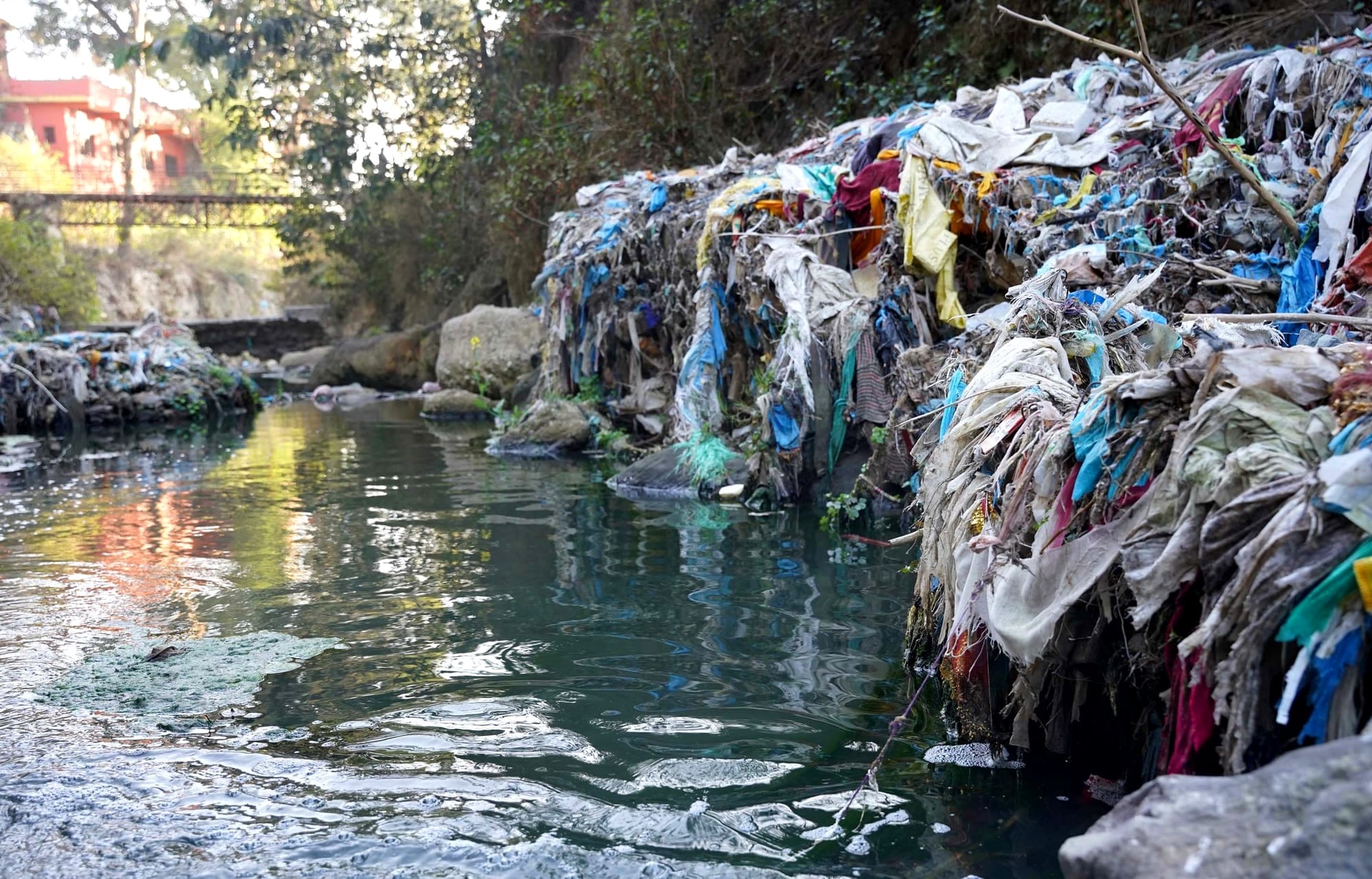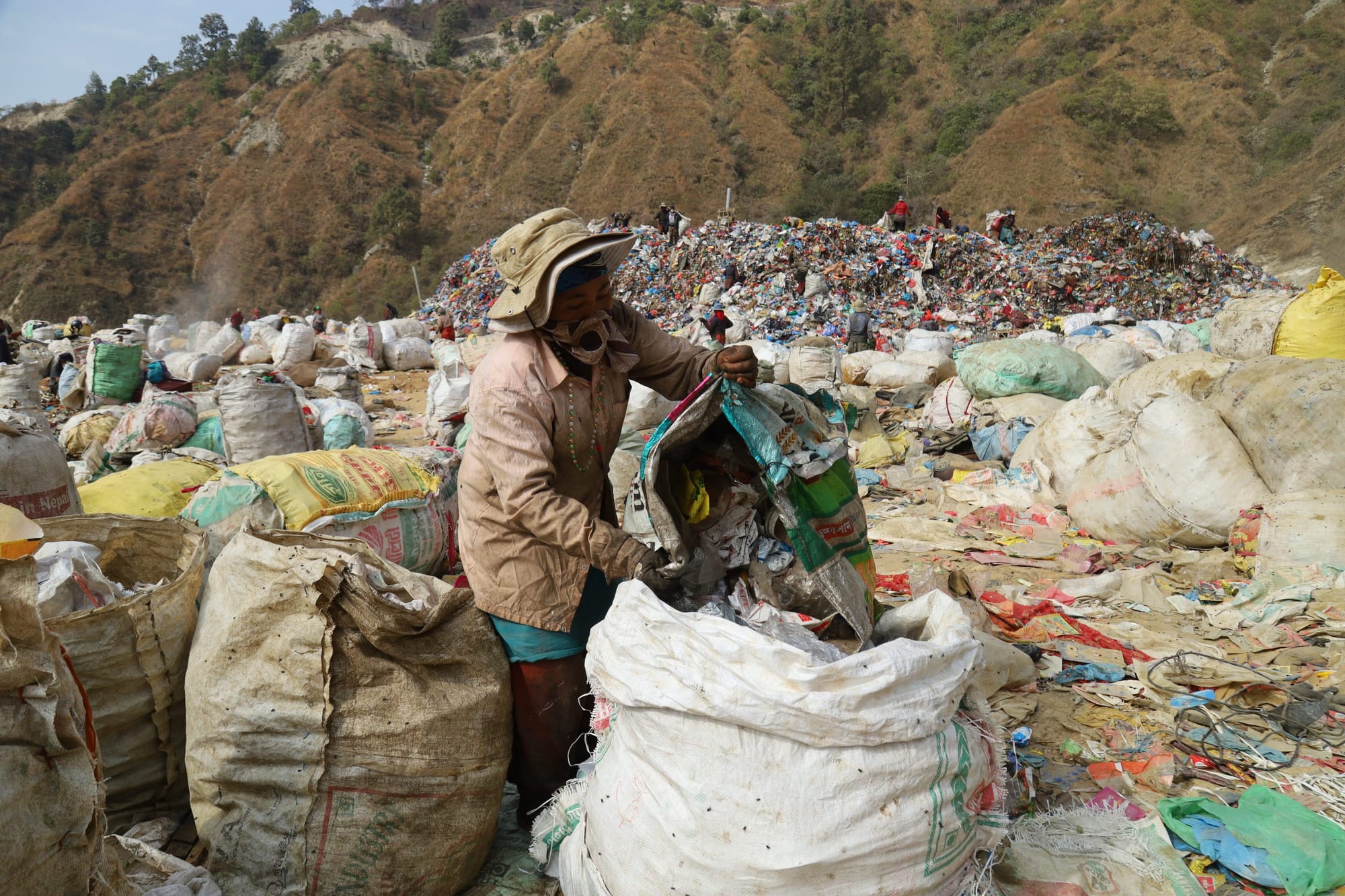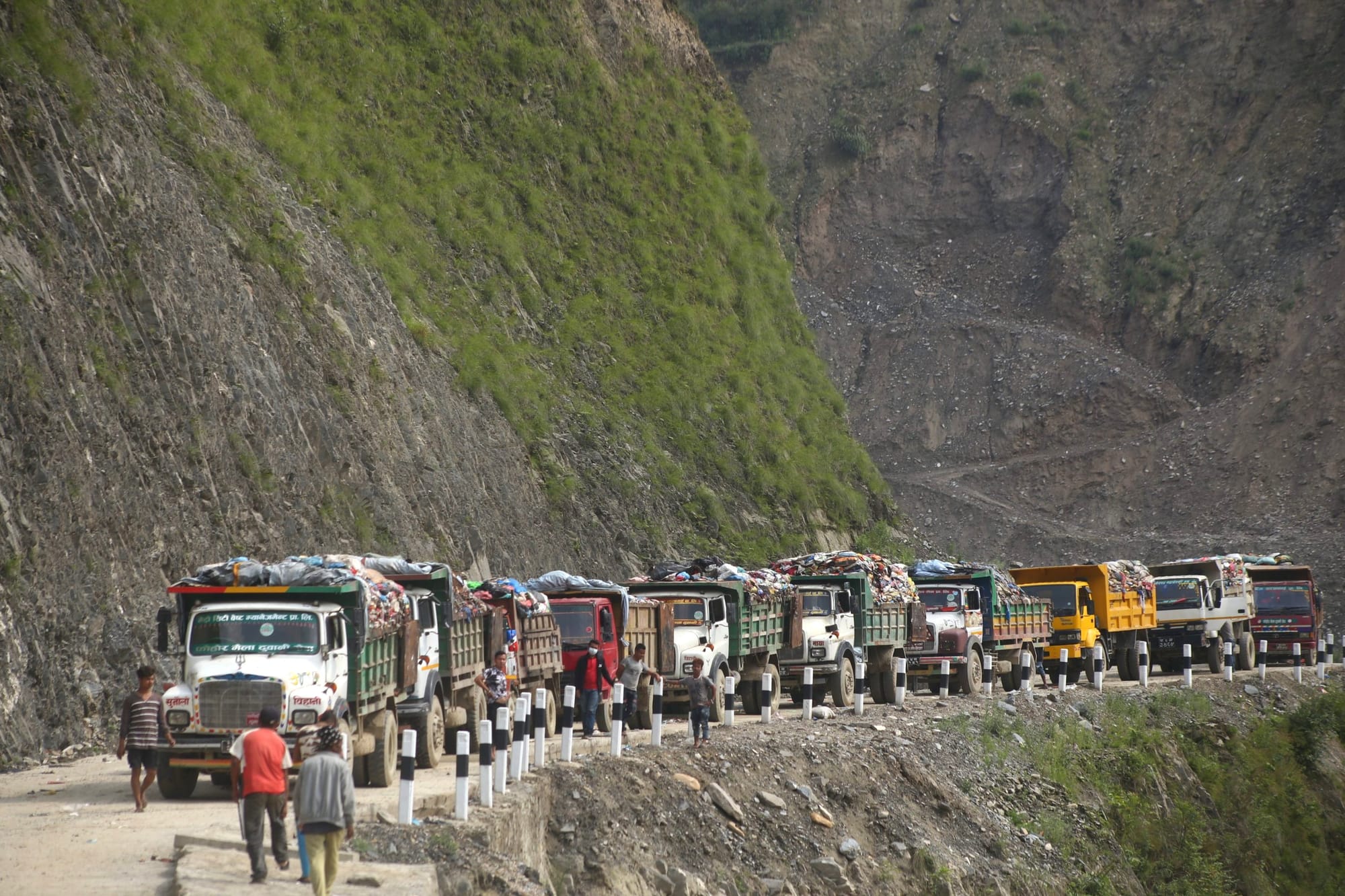Nepal: The Front Line of the Fast Fashion Crisis
New Investigation into textile waste.

Textile waste represents one of the fashion industry’s most urgent crises — and Nepal is quietly bearing the burden. Sandwiched between manufacturing powerhouses China and India, Nepal faces a relentless influx of cheap fast fashion exports that are devastating both its sacred waterways and domestic textile industries.
Written by Tansy Hoskins & Arun Karki.
Originally published by Eco Age.
As the Dhobi Khola river narrows through Nepal’s capital Kathmandu, its steep banks are clogged with brightly coloured shredded clothes. Printed patterns can be seen twisted around denim jeans as pink and yellow tendrils of fabric snag on branches and dangle in the river. Torn purple t-shirts lie next to ripped up boxer shorts and a sneaker with a swoosh logo floats downstream.
Despite their sacred status in Hinduism, rivers once so pure they were safely drinkable from are now used as a dump.
This is evidence that Nepal is on the front line of the fast fashion crisis, a small country flooded with cheap clothes by its two gigantic neighbours.
Nepal is situated between India and China, two economic powerhouses who are giants of modern clothing manufacture. According to the World Bank, China and India export 89 per cent of all clothes and textiles sold in Nepal, accounting for 48 per cent and 41 per cent respectively.
Nepal is being swamped with new clothes and footwear, not all of which are legally imported and because they are so cheap are worn a few times before being thrown away.
“Ready-made garments are coming into Nepal – with the biggest portion coming from China, the second biggest portion is coming from India” says Bhim Kumari Giri, General Secretary of the Garment Association.

Dr. Posh Raj Pandey, Chair Emeritus of the South Asia Watch on Trade, Economics and Environment explained: “We simply can’t compete with China, where low-cost, mass-produced clothing floods the market,”
“The reality is, Nepal remains heavily dependent on imports – not just for ready made clothes, but for most other goods as well.”
While Nepal produces a meagre 0.027 per cent of global greenhouse gasses it is ranked as the fourth most vulnerable country in the world to the impacts of the climate crisis. Refusing to become a dump for the world’s old clothes, Nepal has banned the import of worn clothing.
Yet despite the ban, it has become normal to find piles of clothing, small and large, dotted along riverbanks and left in patches of wasteland around the city. These are discarded new clothes – cheap imports bought in markets and shops. As well as ending up in rivers, fast fashion is also devastating Nepal’s beautiful landscapes and traditional communities.
“Fashion has been literally dominated in Nepal by things that have been imported. They are cheap, available in bulk, and are easy to find… But what is often missing is an awareness of how the clothes are made and at what cost.” – Alpaja Rajbhandari
Alpaja Rajbhandari, founder of Nepali slow fashion label Ekadesma laments: “Nepal is just so very small and the market is totally dominated by China and India, From politics to fashion, we are really affected by them.”
This sandwiching effect is having a devastating impact on Nepal’s ecosystems. From the vast Himalayan mountains to the lowland plains of Tarai, Nepal is a country of 6,000 rivers. The Dhobi Khola is a tributary of the sacred Bagmati River believed to have originated from a great lake that filled the Kathmandu Valley a million years ago.
“It really feels sad to see clothes thrown in the river,” Rajbhandari continues. “I was heartbroken when I saw it after the last floods when all the remaining trees and banks of the river were covered in textile waste and plastics. It was horrible.
“Fashion has been literally dominated in Nepal by things that have been imported. They are cheap, available in bulk, they copy trendy designs, and are easy to find, so people naturally go for it. But what is often missing is an awareness of how the clothes are made and at what cost.”

Waste Mountains
Think of mountains in Nepal and Sagarmatha (Mount Everest), probably comes to mind. But there are other mountain stories in Nepal, including that of the Banchare Danda landfill site and the mountains of waste being poured into it each day.
Twenty seven kilometres from Kathmandu, a cavalcade of open topped garbage trucks winds its way along hill roads – sometimes delayed on their journey by roadblocks manned by angry and worried local residents.
The waste being offloaded is part of a staggering 2.3 billion tonnes of municipal solid waste produced worldwide each year. 92 million tonnes of this is global textile waste – to comprehend just how much this is, picture a rubbish truck full of clothes arriving at a landfill site every second.
Due to a chemically intensive manufacturing process that uses an estimated 15,000 chemicals, textile waste is highly toxic. Once in landfill, clothes made of fossil fuels cause plastic waste, while ‘natural fibre’ clothing produces methane gas during decomposition.
“Sometimes, people wear such t-shirts for only a week or so before throwing them away. Many feel too lazy to take them to tailors for stitching or repair so it feels easier just to dump them.” – Sanu Maiya Maharjan

While Nepal’s environmental laws prevent hazardous waste from crossing into Nepal, the law does not specifically mention clothes, meaning that the textiles coming into Nepal are both disposable and dangerous.
The transformation of pristine farmland into landfill in Nepal has had terrible consequences for the community. The previous site that Banchare Danda replaced had been blamed for crop failures, sick animals, plagues of flies, terrible smells, respiratory conditions and skin diseases.
A cycle driven in part by the global fast fashion industry.
Alarmingly, for both the clothes that are imported, worn – and then buried – Nepal currently has no legislation regulating chemicals in new clothing imports.
While wary of tariffs, the Government has also indicated that it wants to curb imports through anti-dumping legislation and creating the kind of mandatory chemical limits for textile and clothing imports seen in the EU.
Sanu Maiya Maharjan works for the Kathmandu Metropolitan City Office, from her office in the centre of Kathmandu she tells Eco Age that she wants to see the sale of cheap clothes discouraged: “They are not durable and are discarded quickly,” she says. “Sometimes, people wear such t-shirts for only a week or so before throwing them away. Many feel too lazy to take them to tailors for stitching or repair so it feels easier just to dump them.”
The worry, however, is that import restrictions on fast fashion will exacerbate a large black market trade. In 2024, a Nepali Government trade report called the 1,700-kilometre-long open border between Nepal and India ‘a hotspot for organised smuggling activities’.
Large border warehouses are used as hubs for the smuggling of bootleg shoes which end up in shops, costing the Nepali government US$45 million in unpaid taxes each year.

Recycling and Rituals
Environmental group Cleanup Nepal organises groups to clean rivers in Kathmandu. “We found even good quality clothes had been swept away,” says Rabindra Lamichhane, Executive Director of Cleanup Nepal. “Compared to before, we now see maximum textile waste. Outside of urban areas household clothes are thrown away and end up in rivers. When floods occur, clothes get buried in sand and we have to pull them out.”
Speaking from Seattle, Alpaja Rajbhandari says a textile recycling system in Nepal would match traditional Nepali culture. “At home, we recycle and reuse, we don’t throw food away as easily as in Western countries.
“My Mum still has some of my childhood clothes to try and pass them on. The Kawadiwala(scrap merchant) comes round on his bicycle and swaps plastic for a few rupees. Sustainability is in our livelihoods in Nepal.”
While hand-me-downs from relatives or friends is a custom, the wearing of second-hand clothing from strangers is still stigmatised – especially regarding the clothes of the dead which it is believed should be thrown away. “If you go to the Ghats, (the steps down to the river where final cremation and ritual processes are completed), you’ll find that as a ritualistic practice, family members throw the clothes of deceased loved ones directly into rivers,” says Sanu Maiya Maharjan.
She adds: “Not only their clothes, but other textile items such as bedsheets, blankets, and towels,” Maharjan continues. “Public awareness is needed – these clothes could have been given to the poor and needy, whose numbers are significant in Kathmandu.”
There are moves amongst younger generations to end the stigma of second hand clothes. On a busy street, the two storey Affordable Thrift Store has rails of locally donated clothing in the windows. Between 2,500-3000 items are listed each month with sellers receiving 55 per cent of the sale price. If the clothes do not sell, they can be donated to emerging upcycling projects.
“We’ve observed a shift in public perception,” says Operations Manager, Shaswat Jha. “People are beginning to see that they can earn money by selling used clothes, and they can also buy trendy, fashionable items at affordable prices. But there is still some stigma, so our main customers tend to be young people.”

Blocked at every turn
Traditional thrifty solutions are also being replaced. Shredded textile waste is known as Kalo Rooi in Nepal and has traditionally been used to stuff quilts, mattresses, pillows and cushions. However, even this local industry is under threat as China is now exporting shredded rags into Nepal, and at such cheap prices that it undercuts local production.
For now, Nepal’s shops and markets remain full of cheap clothes that have been imported or smuggled in from Nepal’s neighbours.
“In fast fashion, there is convenience and easiness, but in that convenience and easiness there’s loss of traditions, cultural connections, human connections – all of which have a really bad impact on the local circular economy,” Alpaja Rajbhandari concludes. “There’s a lot of hidden truth behind that particular word, convenience.”
- Thank you to my co-author and researcher Arun Karki. Arun is a Nepal-based data journalist and trainer. He has led climate change reporting projects in Nepal and South Asia. Previously spending a decade in video news production at Nepal Television, he holds a master’s degree from Columbia University’s Graduate School of Journalism.
- This investigation was developed with the support of Journalismfund Europe.

- Check out the original story on the newly revamped and relaunched Eco Age.

- I'm grateful to Eco Age for making this their flagship story and to the whole team for their hard work. It's entirely possible these days to work for months on a story only to have it stuck on a small corner of a website, but Eco Age really wanted to work on how to get the investigation read and worked hard on different delivery methods including recording interviews with Arun and I which are being released on Instagram - for which we got an additional fee 👏. I wanted to mention this because there is a lot of bad news about journalism atm so it's nice to have had a positive experience!

Thank you for reading. This newsletter is free - please post it on your socials and forward to a friend or two.
Here again is the link to the original article if you'd like to share it:



